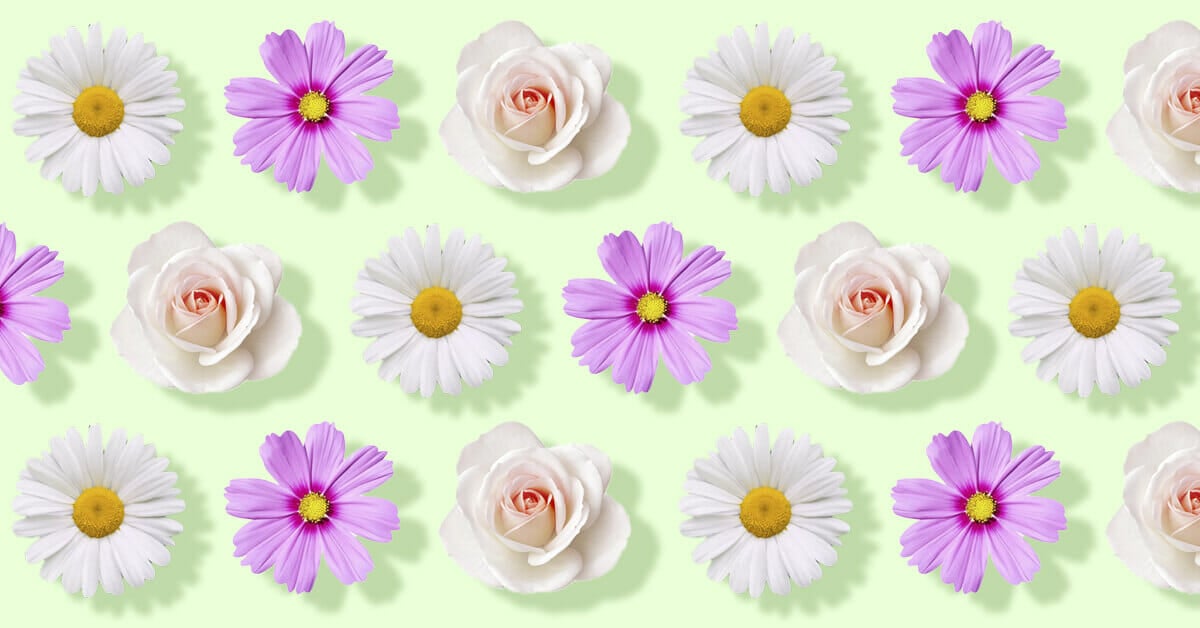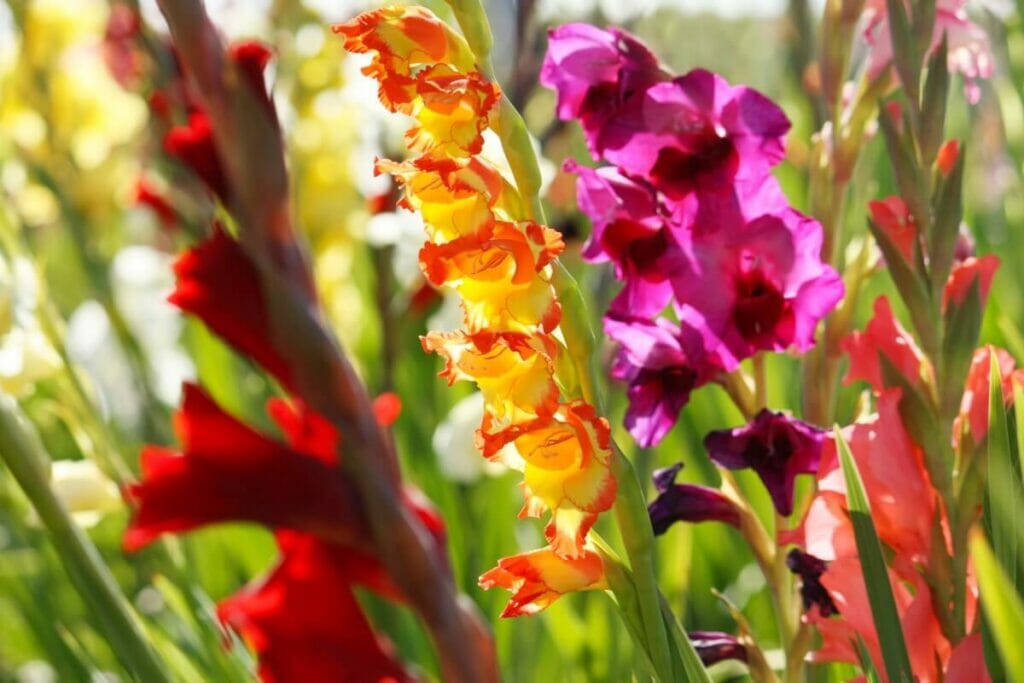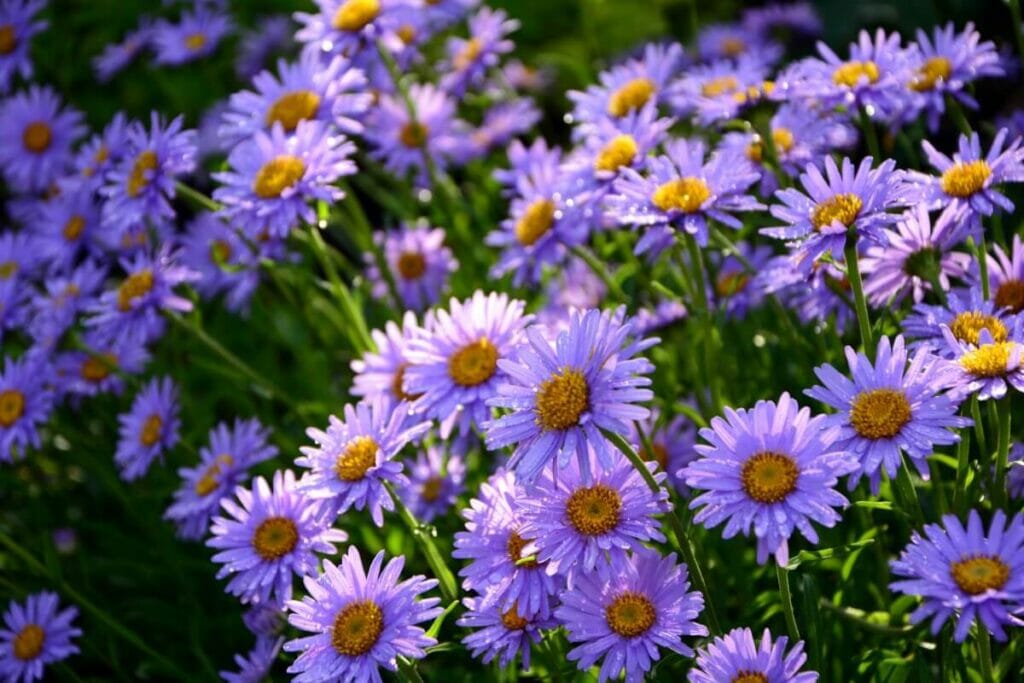The Official Birth Month Flowers and Their Symbolic Meanings
Whether it’s through birthstones or Zodiac signs, our birth month may even determine aspects of our personality. This also extends to birth month flowers, with each month linked to two corresponding birth flowers. It’s thought that the practice started in Roman times because the Romans were one of the earliest societies to celebrate birthdays. In this article, we’ll guide you through each of the official birth month flowers and share their special meaning in the language of flowers.

The Official Birth Month Flower Calendar:
| Month: | Birth Flower: | Meanings & Symbolism: |
| January: | Carnations & Snowdrop | Pink Carnations (love and appreciation), White Carnations (luck, love, and affection, Red Carnations (love and friendship). Snowdrop (hope and rebirth). |
| February: | Violet, Iris, and Primrose | Violets (faithful love, truth, loyalty, humility), Iris (hope, faith, passion, purity, and innocence), Primrose (affection, young love, undying affection) |
| March: | Daffodils | Daffodils (new beginnings, faithfulness, luck, prosperity, and hope) |
| April: | Daisy & Sweet Pea | Daisy (purity, love, new beginnings, fertility, and motherhood). Sweet Pea (blissful pleasure, gratitude). |
| May: | Lily of the Valley & Hawthorn | Lily of the Valley (romance, luck, happiness, purity, humility). Hawthorn (hope, love, beauty, fertility, and supreme happiness). |
| June: | Roses & Honeysuckle | Roses (love, passion, romance, purity, gratitude). Honeysuckle (happiness and eternal love). |
| July: | Larkspur & Water Lily | Larkspur (happiness, love); Water Lily (enlightenment, resurrection, purity, beauty, creation). |
| August: | Gladiolus & Poppy | Gladiolus (integrity, honor, respect); Poppy (remembrance, prosperity, enchantment, sympathy). |
| September: | Aster & Morning Glory | Aster (faith, love, achievement, and wisdom); Morning Glory (affection, intimate love, patience). |
| October: | Marigolds & Cosmos | Marigolds (devotion, commitment); Cosmos (harmony, love, innocence, beauty, modesty, joy, and balance). |
| November: | Chrysanthemum & Peonies | Chrysanthemum (friendship, love); Peonies (romance, prosperity, good fortune, honor, and compassion) |
| December: | Narcissus, Poinsettia, and Holly | Narcissus (innocence and purity); Poinsettia (success, celebration); Holly (happiness and optimism). |

January – Carnations & Snowdrop

The official January birth month flowers are carnations and snowdrops. The carnation is the primary flower, while the snowdrop is the secondary flower.
Birth month flowers may have been chosen because their blooming season corresponded with particular months. Although January is a quiet time for flowers, carnations and snowdrops both bloom during the winter.
Also known as Dianthus, all carnations symbolize love. Different carnation colors also represent other qualities. Pink carnations represent appreciation, red carnations symbolize friendship, and white carnations represent affection and luck.
Snowdrops are one of the first plants to bloom in late winter. Also known as Galanthus, snowdrops are popular for their nodding bell-shaped white flowers. They symbolize hope, purity, and rebirth.
February – Violet, Iris, and Primrose

February has three official birth flowers rather than two. Violets are the primary February flower, followed by primroses as the secondary flower. The third February flower is the iris.
While February is more famous for Valentine’s Day and roses, violets are also associated with Valentine’s Day. One popular story recounts that St. Valentine used crushed violets to write letters to his friends while he was in exile. Violets were also used to make love potions in ancient Greece – an idea borrowed by William Shakespeare in A Midsummer Night’s Dream.
These flowers (Viola genus) are purple, blue, yellow, or white perennials with a delicate fragrance. Violets symbolize faithful love, humility, loyalty, and truth.
Primroses (Primula genus) are colorful perennials with blue, purple, pink, red, yellow, or white flowers. Primroses represent modesty, young love, and undying affection. Irises (Iris genus) symbolize hope, faith, innocence, passion, and wisdom.
March – Daffodils

Daffodils (Narcissus genus) are the only official March birth flowers. These gorgeous perennial flowering bulbs belong to the amaryllis family (Amaryllidaceae). Daffodils are one of the most famous symbols of spring, making them the perfect flower for March.
Daffodils produce large, beautiful trumpet-shaped flowers that are usually yellow. Some flowers also have orange, pink, or white parts. Many ancient cultures celebrated daffodils as heralding the beginning of spring.
In China, daffodils are believed to symbolize good luck and prosperity. This is because daffodil blooms usually last throughout Chinese New Year celebrations. Daffodils are also the national flower of Wales, representing faithfulness.
Daffodils also symbolize qualities like chivalry, happiness, friendship, modesty, and respect. When giving daffodils as floral gifts, always use a bunch of daffodils. A single daffodil bloom is believed to bring bad luck.
April – Daisy & Sweet Pea

The official April birth flowers are daisies and sweet peas. Daisies are the primary April flower, while sweet peas are the secondary flower.
Daisies are a large group of flowers in the aster family (Asteraceae). Some of the most common types of daisies include gerbera daisies and Shasta daisies. Most daisies produce small, single flowers with yellow centers and white petals. Some daisy varieties come in other colors like pink, purple, orange, red, and yellow.
Daisies symbolize love, innocence, purity, new beginnings, fertility, and motherhood. Daisies are traditionally used to convey messages of affection and devotion.
Sweet peas (Lathyrus odoratus) are climbing annuals from the legume family (Fabaceae). They are highly prized for their intoxicating fragrances and gorgeous purple, pink, blue, or white flowers. Sweet peas represent gratitude and blissful pleasure.
May – Lily of the Valley & Hawthorn

May’s official birth flowers are lily of the valley and hawthorn. Lily of the Valley is the primary May flower, while hawthorn is the secondary flower.
Lily of the Valley (Convallaria majalis) is an elegant woodland perennial from the asparagus family (Asparagaceae). These plants produce sprays of delicate, nodding white bell-shaped flowers. These exquisite little flowers create a lovely, sweet scent.
As befits the May birth flower, the Lily of the Valley is sometimes known as the May lily. The Lily of the Valley symbolizes romance, happiness, humility, and purity.
Hawthorn (Crataegus genus) is a gorgeous flowering shrub or tree from the rose family (Rosaceae). They are also known as the May tree because it erupts with aromatic white flowers in May. Hawthorn flowers have a pungent, sweet scent and make excellent hedges.
Hawthorn represents beauty, happiness, hope, love, and fertility. Thanks to their thorny branches, hawthorn shrubs also symbolize protection.
June – Roses & Honeysuckle

The official June birth flowers are roses and honeysuckle. Both of these beautiful plants have aromatic scents that are synonymous with summer. Roses are the primary flower, and honeysuckle is the secondary flower.
What’s more, roses (Rosa genus) are aptly nicknamed “The Queen of Flowers.” Roses are incredibly diverse in terms of color and form, with red and white roses being the most famous. They have been cultivated for thousands of years, starting in ancient China and Japan.
Roses symbolize love, gratitude, passion, purity, and romance. Although roses are mainly associated with Valentine’s Day, they are excellent floral gifts for June birthdays.
Honeysuckles (Lonicera genus) are fragrant perennial vines from the honeysuckle family (Caprifoliaceae). Honeysuckle blooms come in white, pink, red, and yellow and produce pungent fragrances, especially in the evening. Honeysuckle symbolizes happiness, eternal love, and sweetness.
July – Larkspur & Water Lily

July’s birth month flowers are larkspurs and water lilies. Larkspur is the primary July flower, while water lilies are the secondary flower.
Larkspurs (Consolida genus) are tall flowering annuals from the buttercup family (Ranunculaceae). Larkspurs are often confused with delphiniums, which are perennials. Larkspur flowers have a single large petal, while delphiniums have four separate petals.
Larkspurs symbolize love, happiness, joy, positivity, and romance. Purple larkspurs represent affection for a first love, while white larkspurs represent happiness and joy.
Water lilies are aquatic flowers from the Nymphaeaceae family. Water lilies come from both temperate and tropical areas. These floating flowers produce large blooms with strong scents.
Water lilies feature prominently in the mythology of Asian and Eastern cultures. Water lilies symbolize happiness, eternal love, enlightenment, and rebirth.
August – Gladiolus & Poppy

The birth flowers for August are the gladiolus and poppies. Gladiolus is the primary August flower, and poppies are the secondary flower.
Gladiolus are perennial flowers from the iris family (Iridaceae). The genus name Gladiolus comes from ‘gladius’, a Latin word meaning sword. Gladiolus has sword-shaped leaves and huge spikes of pink, purple, red, and white flowers.
Gladiolus flowers are associated with honor, integrity, respect, healing, and strength. As well as being the primary August flower, gladiolus is also the official 40th Anniversary flower.
Poppies are charming herbaceous annuals and popular wildflowers from the Papaveraceae family. They produce colorful cup-shaped flowers on the end of thin stalks.
Poppies symbolize remembrance, happiness, prosperity, and sympathy. Red poppies are used in Western society to commemorate those who have died in armed conflicts, especially World War One.
September – Aster & Morning Glory

September’s birth flowers are asters and morning glory. Asters are the primary September flower, while morning glory is the secondary flower.
Asters are charming little perennial flowers from the Asteraceae family. Some of the more well-known species include China asters and Michaelmas daisies. Asters have daisy-like flowers with yellow centers and colorful petals.
Asters are associated with love, faith, achievement, bravery, patience, and wisdom. In Victorian floriography, asters symbolize charm and daintiness. Along with being the primary September flowers, asters are one of two flowers that celebrate a 20th wedding anniversary.
Morning glory flowers are spectacular climbing annuals from the bindweed family (Convolvulaceae). These flowers have colorful trumpet-shaped purple or white blooms. Morning glory flowers symbolize affection, intimate or unrequited love, and patience. What’s more, they are also used as the 11th wedding anniversary flower.
October – Marigolds & Cosmos

The birth flowers for October are marigolds, which are the primary flowers, and cosmos as the secondary flowers. Both of these plants are annuals from Mexico that continue blooming as fall begins to arrive.
Marigolds come from the Tagetes genus in the Asteraceae family. They’re frequently confused with pot marigolds from the Calendula genus. Marigolds produce cheerful orange, red, or yellow pom-pom-like flower heads.
In the language of flowers, marigolds symbolize commitment, devotion, creativity, joy, and passion. What’s more, they were cultivated by the Aztecs as companion plants for crops. Marigolds are still used today in Day of the Dead celebrations in Mexico.
Cosmos are colorful, attractive flowers from the Asteraceae family and have single open flowers and feathery foliage. Cosmos flowers symbolize beauty, harmony, love, innocence, joy, and balance.
November – Chrysanthemum & Peonies

November’s birth flowers are chrysanthemums and peonies. Both flowers have impressive, colorful blooms that brighten up the darkening days.
Chrysanthemums are flowering perennials from the Asteraceae family. Chrysanthemums are popular as both ornamental plants and cut flowers for bouquets. Chrysanthemum flowers come in several colors and forms, each containing dense ranks of petals.
Chrysanthemums represent friendship and love, making them thoughtful gifts. These lovely flowers are also associated with well-wishes, happiness, good luck, joy, and rebirth.
Peonies are gorgeous ornamental perennials from the Paeoniaceae family. Due to their statuesque blooms, peonies are often called the “King of Flowers.” Peonies come in various colors, including pink, red, yellow, and white. Peonies symbolize romance, compassion, happiness, honor, and prosperity.
December – Narcissus, Poinsettia, and Holly

December isn’t just graced with Christmas, but three official birth flowers as well. December’s birth flowers are narcissus, poinsettias, and holly.
Narcissus flowers come from the same genus as daffodils but are slightly different. Some narcissus, such as paperwhite narcissus (Narcissus papyraceus), bloom in December. Paperwhite narcissus produces clusters of small white flowers and symbolizes purity, simplicity, and sweetness.
Poinsettias are popular Christmas flowers, especially as houseplants. They are native to Mexico and Central America and come from the spurge family (Euphorbiaceae). Poinsettias have striking red bracts and green leaves. Poinsettias symbolize purity, celebration, and success.
Holly is a quintessential Christmas plant famed for its spiky leaves and red berries. It comes from the Ilex genus of the Aquifoliaceae family. Holly signifies happiness and optimism and is extremely symbolic in Christianity.
Wrapping Up The Official Birth Month Flowers
Birth flower bouquets are beautiful and unexpected birthday gifts. Each birth month flower carries lots of meaning and symbolism, whether you’re gifting them to friends or family. Each month has two birth flowers because some species aren’t available in certain areas. It’s thought that the practice began in Roman times.
Edd is a budding content writer and gardener living in the United Kingdom. He has a bachelor's degree in Creative and Professional Writing and has written for several gardening publications online. He is passionate about nature and sustainability with a focus on gardening and wildlife.


Hey Edward, love the article! Just curious, why are Peonies listed for November? I always thought they bloomed in like spring or early summer. Did I get it wrong or something?
Hi Eliza – the most likely explanation is that peonies symbolize prosperity, good luck, love, and honor and are often used on festive occasions and are particularly significant in Eastern cultures, including Chinese and Japanese traditions, where they hold strong symbolic meanings throughout various times of the year.
didn’t know flowers had months lol
ok but how do they decide which flower goes with which month? seems kinda random to me. like why daffodils in march? just cause they yellow like the sun starting to come out more or what?
Hi Terry – it’s thought that the Romans were one of the earliest societies to give birth month flowers. Official birth month flowers can also vary between different cultures and countries.
Roses in June is just perfect. So romantic!
if my birth flower is a water lily, does that mean i should live in a pond? asking for a friend lol
Only if you promise to wear green and sing to frogs all day.
I find the choices fascinating, Edward. Is there a historical significance behind each flower to its month, or is it more of a modern tradition? It would be interesting to know the origins!
Edward, good overview but you’ve missed mentioning that some flowers like the chrysanthemum have different meanings across cultures, which could add another layer to why they’re chosen for certain months. Would love to see an expansion on that!
This was lovely to read. Makes me want to plant my own birth month flower garden!